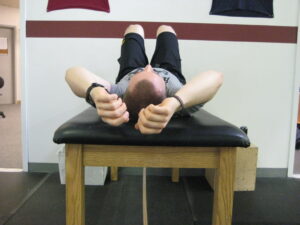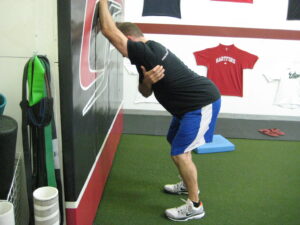Strategies for Correcting Bad Posture – Part 2
Today, we move forward with more strategies for correcting bad posture. In case you missed it, be sure to check out Strategies for Correcting Bad Posture: Part 1. We pick up with tip #5…
5. Don’t overlook a lack of glenohumeral (shoulder) joint internal rotation. When it comes to bad posture, everyone thinks that the glenohumeral joint is only a “player” when it’s stuck in internal rotation; that is, the ball – or humeral head – is rotated too far forward on the socket – or glenoid fossa – meaning that the individual just doesn’t have adequate external rotation. And, this is often true – especially in non-athletic populations.
However, you’ll also very commonly see poor posture folks who present with big glenohumeral internal rotation deficits (GIRD), particularly on the right side (for very legitimate reasons that go well beyond the scope of this article). This is much more common in athletes, particularly overhead throwers (read more: Static Posture Assessment Mistakes). When the posterior rotator cuff is stiff/short and there is an internal rotation deficit, we have to substitute excessive scapular protraction (winging) or thoracic flexion/rotation each time we reach for something.
So, for many folks, posterior shoulder mobility and soft tissue work is an important inclusion in cleaning things up in terms of appearance, function, and shoulder health. If – and only if – you’ve been assessed and it’s been determined that you have an internal rotation deficit that compromises your total motion at the glenohumeral joint, you can integrate some gentle sleeper stretches (scapula stabilized!) to get a bit more ROM in the posterior cuff.
6. Don’t overlook a lack of glenohumeral (shoulder) joint flexion. The shoulder is a tremendously mobile joint, so we need to appreciate what goes on outside the transverse plane as well. In particular, I see shoulder flexion limitations as a big problem. These limitations may come from the lat, teres major, long head of the triceps, or inferior capsule. Another overlooked cause can be posterior cuff restrictions; it’s not uncommon to see both GIRD and major shoulder flexion limitations on the same side. As the picture below shows, the infraspinatus and teres minor run almost vertically when the arm is abducted a mere 90 degrees – which means that they’re struggling to lengthen fully to allow full shoulder flexion (and abduction, for that matter).
These restrictions that can contribute to both faulty compensation patterns in certain positions, as well as overall bad posture chronically. Let’s have a look at what these issues look like in the real world. First, in someone with a shoulder flexion limitation, you’d first want to check them in the supine position, with the knees flexed and back flat (to avoid substituting lumbar extension for shoulder flexion). Ideally, the arms should rest flat on the table – so this would be a “not-so-hot” result (especially since the arms “fall” to the sides a bit instead of staying in “attempted flexion”):
Next, let’s take this same shoulder flexion limitation, and look at what would happen actively. In the first three reps of the video below, take note of the position of our subject’s head at the start and finish of each rep; you’ll see that as he “runs out” of shoulder flexion, he substitutes forward head posture. On the next three reps, after I cue him to keep his cervical spine in a more neutral posture, he has to arch his back excessively (lumbar hyperextension) to complete the movement.
Now, imagine taking this walking disaster (only kidding; I had Dave fake it for the video, as he’s actually a finely tuned trained killing machine who can’t be stopped by conventional weapons – and he’s single, ladies) taking up overhead pressing, Olympic lifting, or just reaching for a glass on the top shelf. Then, imagine him doing those tasks over and over again. Obviously, the posture will get worse as he reinforces these compensation schemes – but something is going to surely break down along the way; it’s just a question of whether it’s his low back, shoulder, or neck!
Correcting these issues is easier said than done; as I noted, there are several structures that could be the limiting factor. However, for those looking for a relatively universal stretch they can use to get a bit of everything, I like the wall lat stretch with stabilization, one piece of a comprehensive (but not excessive and boring) static stretching program included in Show and Go.
7. Don’t ignore the thoracic spine. The previous two examples focused exclusively on the glenohumeral joint, but the truth is that it is tremendously dependent on thoracic spine positioning. Ask any physical therapist, and they’ll tell you that if they can get the thoracic spine moving, they can instantly improve glenohumeral joint range-of-motion without even touching the shoulder (this is incredibly valuable with folks who may have stiff glenohumeral joints that can’t be mobilized aggressively following shoulder surgery; they need ROM in any way possible). And, truthfully, you can substitute a lack of thoracic spine extension for the shoulder flexion problems and compensation schemes above, and a lack of thoracic spine rotation can work in much the same way as a GIRD (substitute excessive scapular protraction with reaching tasks).
If you ever want to quickly check to see what limiting thoracic extension does to someone’s upper body posture, just put them in supine position and push the sternum/rib cage down – which will bring the thoracic spine into flexion. Watch what happens to the position of his chin, and the size of the “gap” between his neck and the table:
Now, just consider what kind of “yank” this puts on the sternocleidomastoid chronically…
…and you’ll understand why a lack of thoracic spine mobility can give people enough neck pain and tension headaches to make Lindsay Lohan’s hangovers look like a walk in the park. And this doesn’t even consider what’s going on with scalenes, suboccipitals, levator scapulae, subclavius, and a host of other muscles that are royally pissed off! Also, think about all those folks in your gym doing hours and hours of crunches (especially while tugging on the neck). Ouch.
For that reason, we need to get our thoracic spine moving – and more specifically, we need to get it moving in both extension and rotation. I’ve mentioned in the past that the side-lying extension-rotation is one of my favorites (assuming no symptoms); remember that the overwhelming majority of the range-of-motion is coming from the upper back, not just the shoulder:
Here’s another we’re using quite a bit nowadays in our folks who have good internal rotation (which we want to keep!):
8. Watch your daily habits and get up more frequently. I’m at 1,140 words for this post right now – plus several pictures and videos. In other words, some of you might have been hunched over your computer screens trying to figure out what I’m saying for over 20 minutes now – and that’s when “creep” starts to set in an postural changes become more and more harmful (both aesthetically and functionally).
With that in mind, make a point of getting up more frequently throughout the day if you have to be sitting a ton. Likewise, “shuffle” or “fidget” in your chair; as Dr. Stuart McGill once said, “The best posture is the one that is constantly changing.” Now, shouldn’t you get up and walk around for a few minutes?
I’ll be back soon with Part 3 of this series, but in the meantime, I’d encourage you to check out Show and Go: High Performance Training to Look, Feel, and Move Better, a comprehensive program that includes many of the principles I have outlined in this series.
Sign-up Today for our FREE Newsletter and receive a deadlift technique tutorial.








